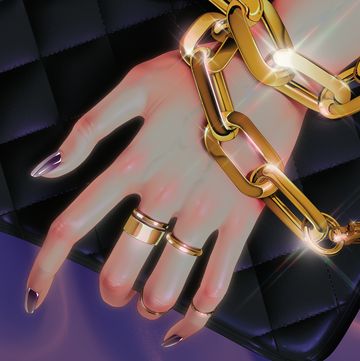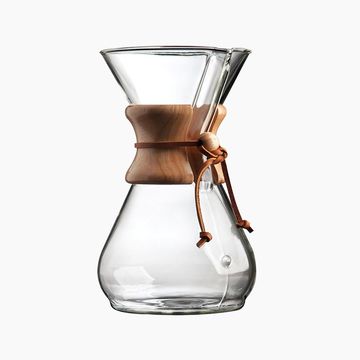I own a teacup that has the words every day I'm hustlin' scrawled around the rim. Filled with bow-shaped paper clips and other ephemera, the teacup sits on my desk as a reminder: to work hard, to keep going, to aim high, and prioritize productivity. Yet it is only at my elbow for an hour at a time at most; most days, I can only see the self-satisfied teacup from my bed. For the majority of each day, I am in one bed or another. Much of that time, I'm lying with my eyes closed and listening to an audiobook. I am not, in fact, hustlin'. I am a chronically ill woman, stuck on the sidelines.
In 2012, I became convinced that I'd developed tendonitis, or perhaps carpal tunnel syndrome. I was visiting my company's home office in Pittsburgh, where my wrists and hands began to twinge with pain. My colleagues, who also worked all day at their computers, clucked with sympathy at my discomfort; many of them wore wrist braces, and ergonomic keyboards were available to employees who requested them. I thought the pain was a natural side effect of my grueling work habits. I woke at 4 a.m. every morning to write for four hours before getting ready for work, and drank enough coffee to cause spontaneous, caffeine-sick vomiting up to three times a day. The pain in my hands, I assumed, was like the vomiting. I could put up with it. I was, after all, ensconced in a culture of creatives in the tech industry—people who humblebragged about how little sleep they'd gotten the night before and used the phrases "lean and scrappy" to describe not only our company culture, but themselves.
But other things began to happen. In 2013, the pain appeared in my feet and legs as well, earning me the diagnosis of peripheral neuropathy, or damage to the nerves in my hands and feet. Then, on an autumn trans-Atlantic flight, I unexpectedly fainted. A seizure was suspected, but never proven. I began to have trouble walking in a straight line. I developed delusions. My psychiatrist, who had never seen me so ill, suggested the possibility of anti-NMDA receptor encephalitis, a neurological disease most notably chronicled in Susannah Cahalan's memoir, Brain on Fire: My Month of Madness. During a neurological exam, I was given three minutes to say as many words as I could think of that started with D—I came up with five or six and was asked to remember a series of numbers that I'd have to recite later. My husband Chris accompanied me to the elevator afterward. "She didn't even ask me about those numbers," I complained. He paused and then said, gently, "Yes, she did. You knew all of them."
I didn't have anti-NMDA receptor encephalitis, but blood tests revealed the presence of antibodies that, according to the doctors, either meant cancer or a number of rare autoimmune disorders. More tests ensued, including an EEG and an MRI. Still, no one knew what was wrong with me. Too unwell to work, I left my job and went on disability benefits. In 2015, I was ultimately diagnosed with late-stage Lyme disease—a controversial diagnosis in the United States, where the Centers for Disease Control maintains tightly circumscribed criteria for the disease, and does not believe that terms such as "chronic Lyme" ought to be used at all. (This is based in the belief that there is no convincing scientific evidence that a persistent B. burgdorferi infection causes so-called "chronic Lyme" symptoms.) And yet I believe that this diagnosis, which I was given by a "Lyme-literate doctor," has saved me.
I began the long, hard slog of high-dose antibiotic therapy. Despite the pills, I remained sick. On some days, I was too weak to move my arms or legs; on the worst days, I was too weak to swallow or breathe without difficulty. In late November 2015, I stopped taking antibiotics and began an experimental treatment, known as Low-Dose Antigen Immunotherapy that is designed to calm a dysfunctional immune system by stimulating the production of T Regulator cells and which enabled me to partially function on most days. This is where I am now: too sick to go back to full-time work, freelancing and building a small online business with what energy I do have, and still alive enough to know how much I'm not doing.
Here are things that I can and can't do. I can, on most days, work for approximately two or three hours a day, using bits of time here and there with breaks for rest. I can't, on most days, function well after approximately 2 p.m., which is when I begin to develop fevers, moderate to severe nausea, weakness, fatigue, and a cornucopia of other symptoms that I never get used to, no matter how often they come to call. I can do some fun and exciting things, given certain accommodations. I recently traveled to Los Angeles for the Association of Writers and Writing Programs conference (AWP), spoke on a panel, and gave a reading to promote my debut novel, which I'd written in the five years before I became ill. However, I can't serve as the managing editor of a major media site—a job that I was recently offered—because my body and mind can't handle that kind of workload, no matter how much I long to take it on.
It's said that the disabled are the largest stigmatized population of which any person can become a member at any time. This frequently comes to mind when I see people on social media speak with a certain amount of pride about hustling so hard that they haven't slept more than a few hours in a week. When I see women that I admire scoff at the idea of self-care, I shrink because I'm often reading their words on my phone while lying in bed, engaging in the most intense self-care that I can manage.
Should things be just a little bit different, I'd be right there alongside them. After all, my work ethic and ambition haven't gone anywhere, despite my dedication to doing nothing for hours per day. It's my work ethic and ambition that call my "doing nothing" laziness; and laziness, or sloth, is cause in our go-go-go society for shame of the highest order. In "On Productivity Anxiety," writer Rachel Vorona Cote recounts her need for "ritualistic assurances" of productivity from her husband. "Did I work enough today? Did I seem productive?" are the questions she asks of him before ultimately falling asleep. In a society that holds productivity as unequivocally good, to do less feels like a moral failing.
While working with my counselor, I've frequently brought up the topic of whether or not I am, in fact, lazy. It's a question that I compulsively ask. As someone who used to define herself vis-a-vis her work ethic, to become unable to act upon that work ethic is nearly intolerable. My deep fear is that I'm secretly slothful and am using chronic illness to disguise the sick rot of laziness within myself. Surely I can rouse myself from this bed and bring myself to my desk? Surely I can pull myself up by the bootstraps and force myself to work? Instead of bragging online and in person about how much work I've accomplished, I post selfies from my bed, as if to prove that I am, indeed, ill. Compounding my shame is the private investigator sent after me last fall by my insurance company—a common practice in disability benefits cases—who reported that I was seen "smiling and laughing" after a doctor's appointment, clearly a sign that all was well and good. Surely, then, I could be making myself useful. My disability benefits were pulled last September. I was horrified by the outcome, but, laughably, too ill to fight the ruling.
These days, I continue to surround myself with reminders of my former self. I dream of a future self, in remission and free of illness, who uses her pink Goal Digger pencil case without self-consciousness. Though it might be better to realize my worth outside of productivity, I continue to live in a society that praises the art of getting things done over all else—including wellness and rest—and these are values I can't seem to shake.
Perhaps the solution is to view what I am doing through a different lens. My work, although it may not look like work to most, is to take care of myself. I must care for my health with as much attention as I once paid to the documents I was hired to edit, or to the long hours spent at the office on Saturdays. Aggressive pursuit of one's ambition is a skillset that, I hope, has not left me. In the meantime, I am aggressively pursuing a dream of recovery.
Esmé Weijun Wang is an essayist and the author of The Border of Paradise: A Novel, published by Unnamed Press in April 2016. Her work has appeared in Salon, Catapult, The Believer, The New Inquiry, and Jezebel. She writes at esmewang.com and tweets at @esmewang.













